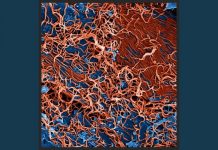
May 21 (UPI) — Researchers have identified two antibodies from an Ebola survivor that can protect mice and ferrets from related viruses.
The study, conducted by the National Institute of Allergy and Infectious Diseases, or NIAID, revealed two antibodies capable of protecting against multiple species in the Ebola virus lineage.
Previous studies have identified one antibody from a mouse that was able to protect other mice against multiple different species in Ebola virus lineage.
Researchers analyzed 349 human monoclonal antibodies from the blood of one survivor of the West African Ebola outbreak caused by the Zaire Ebola virus, finding two antibodies — ADI-15878 and ADI-15742 — which recognized a section of protein found on the surface of the Ebola virus called the GP fusion loop.
The study showed that when access to the GP fusion loop is given, the antibodies could block the five related Ebola viruses from entering a host cell. When researchers tested this with human cells in a laboratory setting, the antibodies protected the cells from becoming infected with several different virulent Ebola viruses.
Researcher tested the antibodies in wild-type mice, mice genetically altered to be susceptible to Sudan Ebola virus, and ferrets. The wild-type mice treated with antibodies after being exposed to the Zaire Ebola virus showed a protective effect from the virus. Genetically altered mice were protected from the Sudan Ebola virus after treatment with the antibodies, and ferrets had a similar protective effect from the antibodies after exposure to the Bundibugyo Ebola virus.
The study was published in the journal Cell.





